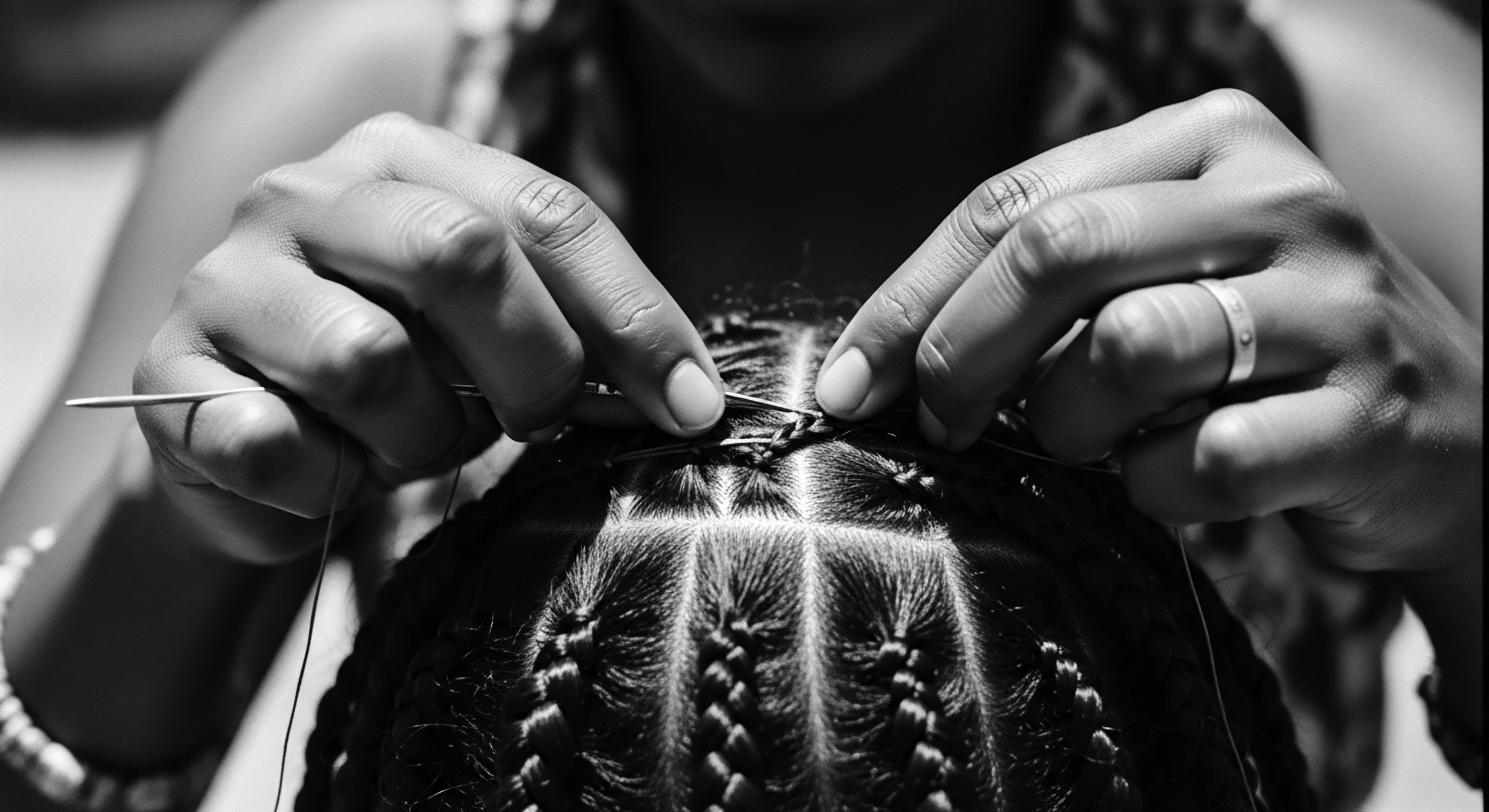
Fundamentals
Within the sacred archive of Roothea, a living repository of textured hair’s profound journey, the concept of Sebum Distribution emerges as a foundational truth, a biological rhythm that has shaped ancestral care practices and continues to guide our understanding of hair health. Sebum, a naturally occurring, lipid-rich substance, originates from microscopic glands nestled within the scalp’s embrace, adjacent to each hair follicle. This golden elixir, produced by the sebaceous glands, acts as the scalp’s innate moisturizer and conditioner. Its elemental purpose is to cloak the skin and hair in a protective veil, a subtle shield against environmental aggressors and a vital source of lubrication.
The true meaning of Sebum Distribution, at its most straightforward level, refers to the manner in which this vital oil spreads across the scalp’s surface and descends along the hair shaft. For individuals with textured hair, particularly those with curls, coils, and kinks, this seemingly simple biological process takes on a distinctive character. Unlike straight hair, where sebum can readily glide down a smooth, linear path, the intricate helical structure of textured strands presents a natural labyrinth. Each curve, each coil, becomes a gentle impediment, slowing the descent of sebum and often leaving the hair ends longing for the nourishment that saturates the scalp.
This inherent characteristic of textured hair meant that from the earliest days, communities deeply connected to the land understood the subtle whispers of their hair’s needs. They recognized that the scalp might feel abundant with its natural oils, while the lengths and ends might thirst for external sustenance. This observation, rooted in lived experience and passed down through generations, formed the initial, unspoken definition of Sebum Distribution within ancestral hair care. It was not a term in a lexicon, but an embodied understanding, a sensory awareness of where the hair was nurtured and where it yearned for additional tender attention.
Early care practices, born from this intuitive knowledge, often centered on methods designed to encourage this essential oil’s journey. Simple yet profound rituals were devised to stimulate the scalp, coaxing the sebaceous glands to release their gifts, and then gently guiding these oils along the intricate pathways of the hair. This was a dance with nature, a respectful collaboration with the body’s own rhythms, long before the advent of scientific laboratories or complex formulations. The wisdom resided in the hands that massaged, the fingers that detangled, and the plant-based emollients that augmented nature’s design.
Sebum Distribution, at its core, is the natural journey of the scalp’s protective oils along the hair, a path uniquely shaped and often slowed by the exquisite curves of textured strands.
These ancestral insights into the hair’s intrinsic needs laid the groundwork for countless hair traditions. The very act of caring for textured hair became an affirmation of its distinct beauty and a response to its particular biological blueprint. It was a recognition that what might be considered ‘dry’ by some was, in truth, a natural consequence of the hair’s glorious design, necessitating a specific, informed approach to care.
- Scalp Stimulation ❉ Gentle finger movements and massage techniques were often employed to awaken the sebaceous glands and encourage the flow of natural oils from the root.
- Hair Sectioning ❉ The practice of dividing hair into smaller sections for detangling and styling inherently allowed for more deliberate application of oils and butters to each strand, aiding in more even distribution.
- Natural Complements ❉ Ingredients such as plant-derived oils and butters were selected for their emollient properties, providing the external lubrication that textured hair often required beyond its naturally occurring sebum.
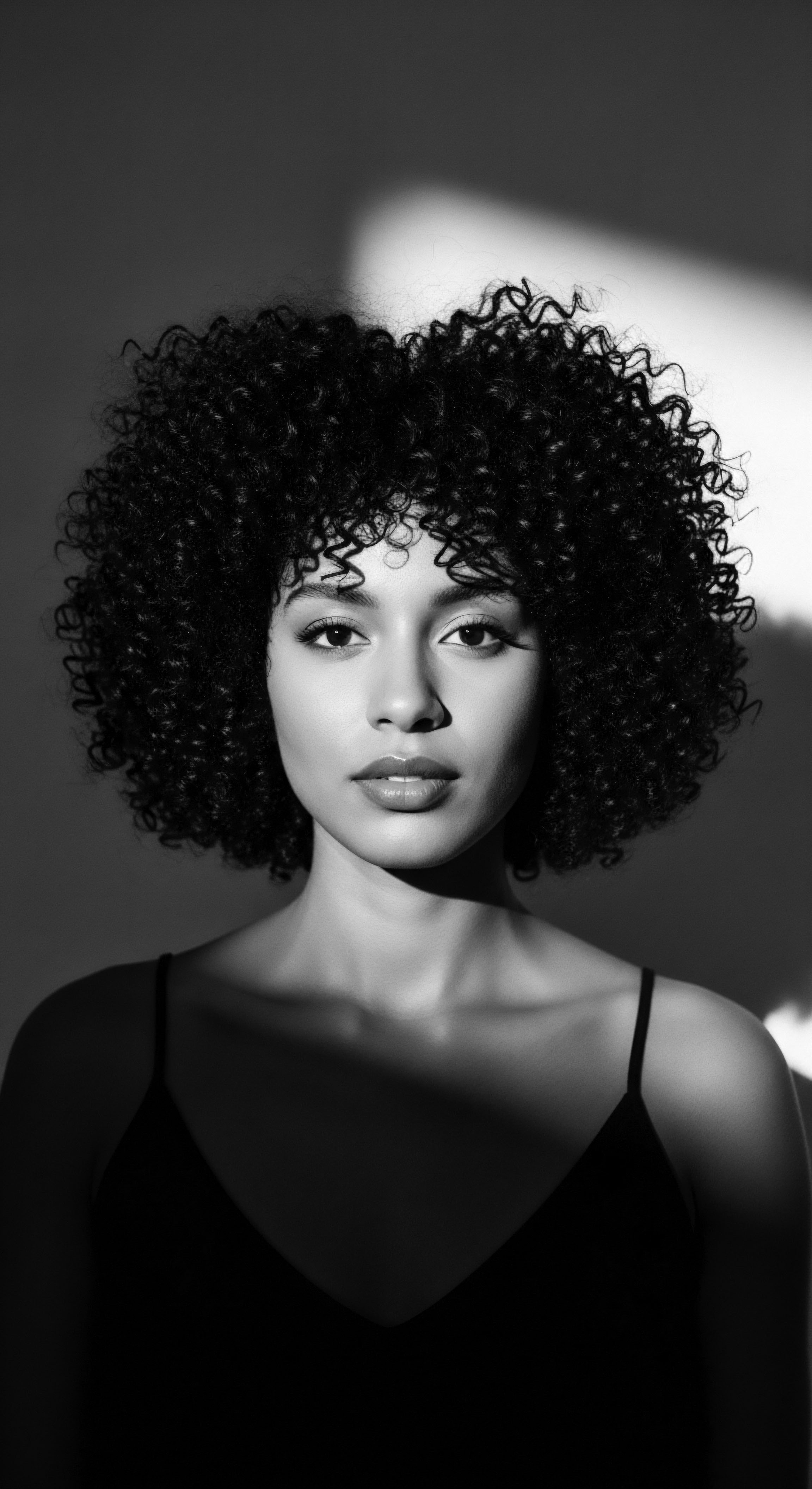
Intermediate
Moving beyond the foundational understanding, an intermediate exploration of Sebum Distribution delves into the biological intricacies and the historical adaptations that shaped hair care for textured hair communities. The sebaceous glands, though microscopic, are diligent architects of the scalp’s health, secreting a complex mixture of triglycerides, waxes, fatty acids, and squalene. This lipid symphony forms the hydrolipidic film, a protective layer that not only lubricates the hair but also maintains the scalp’s pH balance and acts as a barrier against microbial proliferation. However, the journey of this essential film along the hair shaft is significantly influenced by the hair follicle’s unique morphology.
For individuals with highly textured hair, the hair follicle itself is often elliptical or even flat in cross-section, causing the hair strand to grow in a curvilinear, often S-shaped or zig-zag pattern, rather than a straight line. This retro-curvature of the follicle and the subsequent coiling of the hair shaft inherently challenge the smooth, unimpeded flow of sebum from the scalp to the ends. The oil, designed to travel along the hair’s surface, encounters numerous twists and turns, making its complete descent a laborious endeavor. This physiological reality means that while the scalp might experience an accumulation of sebum, the mid-lengths and ends of textured hair often remain in a state of relative dryness, making them prone to brittleness and breakage.
The curvilinear path of textured hair strands naturally impedes the even distribution of sebum, highlighting the necessity of ancestral oiling practices that provided external lubrication.
Historically, this biological predisposition informed the evolution of hair care practices within Black and mixed-race communities. Faced with the practical reality of hair that thirsted for moisture beyond what its natural oils could provide, ancestral wisdom cultivated ingenious solutions. These were not merely cosmetic gestures; they were acts of profound care, deeply interwoven with cultural identity and resilience.
The selective application of plant-based emollients, often derived from indigenous flora, became a cornerstone of hair wellness. These practices transcended simple hygiene, becoming rituals that affirmed connection to heritage, community, and the earth itself.
Consider the profound significance of shea butter (Vitellaria paradoxa), a staple across West Africa, or the rich history of castor oil (Ricinus communis) in various diasporic communities. These were not arbitrarily chosen; their fatty acid profiles and occlusive properties offered tangible benefits, mimicking and supplementing the natural sebum that struggled to reach every coil. These traditions underscore a sophisticated, albeit unwritten, understanding of hair biology, where the efficacy of a substance was measured by its ability to nourish, protect, and enhance the hair’s natural vitality.
The impact of colonialism and the subsequent imposition of Eurocentric beauty standards often disrupted these time-honored practices. The perception of textured hair as “unruly” or “unmanageable” directly undermined the ancestral knowledge that recognized its unique needs and beauty. This era saw the introduction of harsh chemical straighteners and styling tools designed to alter the hair’s natural structure, often at the expense of its health.
Yet, even amidst these pressures, the spirit of ancestral care persisted, adapting and finding new expressions. The communal act of hair braiding, for instance, not only served as a protective style but also provided opportunities for applying oils and discussing hair health within a shared cultural context.
The following table illustrates the convergence of traditional wisdom and contemporary understanding regarding the role of external emollients in managing sebum distribution for textured hair:
| Ancestral Practice Scalp Massage with Oils |
| Underlying Principle (Heritage Context) Stimulating the scalp to encourage the flow of natural oils, promoting a healthy environment for hair growth and conditioning from the root. |
| Modern Scientific Link (Sebum Distribution) Increases microcirculation to the hair follicles, potentially supporting sebaceous gland function and facilitating the initial spread of sebum. |
| Ancestral Practice Application of Plant Butters (e.g. Shea, Cocoa) |
| Underlying Principle (Heritage Context) Providing deep, lasting moisture and a protective barrier against environmental dryness, recognized for their ability to soften and make hair pliable. |
| Modern Scientific Link (Sebum Distribution) Lipids in these butters mimic the occlusive and emollient properties of sebum, coating the hair shaft and preventing moisture loss, particularly at the drier ends. |
| Ancestral Practice Hair Oiling/Greasing (Pre-wash or Styling) |
| Underlying Principle (Heritage Context) Nourishing the hair and scalp, reducing friction during styling, and enhancing shine, a tradition often passed down through generations. |
| Modern Scientific Link (Sebum Distribution) Supplements the unevenly distributed natural sebum, providing external lubrication to the hair shaft, reducing inter-fiber friction, and protecting the cuticle. |
| Ancestral Practice These enduring practices, rooted in ancestral knowledge, offer profound lessons on supporting textured hair's unique needs in relation to its natural oil balance. |
The intermediate perspective on Sebum Distribution thus reveals a dynamic interplay between inherent biological design and the adaptive brilliance of human culture. It speaks to a legacy of care that recognized and responded to the hair’s call for balance, a legacy that continues to inform and enrich our understanding of textured hair wellness today. The tenderness woven into these practices served as a bulwark against environmental challenges and, later, against cultural erasure, safeguarding the hair’s vitality and its symbolic meaning.
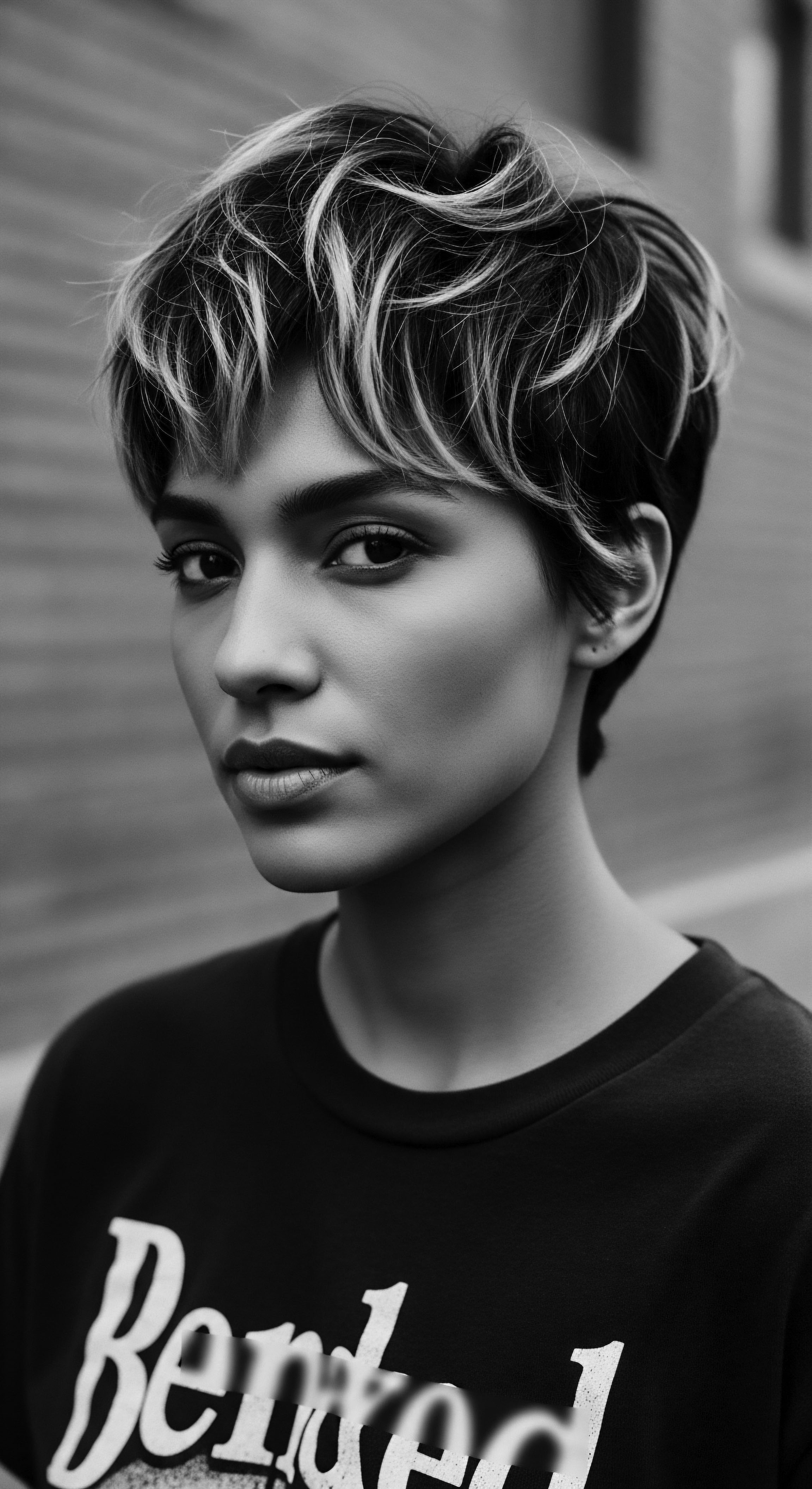
Academic
The academic definition of Sebum Distribution transcends a mere description of oil on hair; it represents a complex interplay of physiological mechanisms, structural morphology, and socio-cultural dynamics, particularly pronounced within the context of textured hair heritage. Sebum, a highly specialized lipid secretion, originates from the holocrine sebaceous glands, which undergo a process of cellular disintegration to release their contents into the hair follicle. This secretion, composed of triglycerides, wax esters, squalene, and free fatty acids, forms the cutaneous hydrolipidic film, a vital component of the skin’s barrier function and the hair’s intrinsic conditioning system. The inherent purpose of sebum is multifaceted ❉ it lubricates the hair shaft, provides antimicrobial protection to the scalp, and contributes to the hair’s pliability and sheen.
However, the efficient and equitable dissemination of this protective film along the entire length of the hair shaft is profoundly influenced by hair typology. Afro-textured hair, characterized by its elliptical cross-section and pronounced helical or coiled growth pattern, presents a unique physiological challenge to sebum distribution. The tortuous path of these strands, with their numerous twists, turns, and points of curvature, physically impedes the downward migration of sebum from the scalp.
Consequently, while the scalp of an individual with highly coiled hair may exhibit normal or even elevated sebum production, the distal portions of the hair shaft often experience a significant deficit in natural lubrication, rendering them inherently more susceptible to dryness, friction-induced damage, and breakage. This inherent biological reality underscores why external conditioning and oiling have been, and remain, not merely cosmetic enhancements but essential care practices for textured hair.
The academic lens reveals Sebum Distribution as a dynamic interplay of biological function and hair morphology, critically impacting the resilience and care needs of textured hair.
This scientific understanding finds a profound echo in the ancestral wisdom of Black and mixed-race communities. Generations before the advent of trichology as a formal discipline, indigenous peoples developed sophisticated systems of hair care that implicitly addressed the unique challenges of sebum distribution on coiled hair. Their practices were not based on chemical analysis but on keen observation, deep empirical knowledge, and a symbiotic relationship with their natural environment. The traditional use of specific plant-derived lipids and emollients, often applied with meticulous care and ritualistic significance, stands as compelling evidence of this ancestral insight.
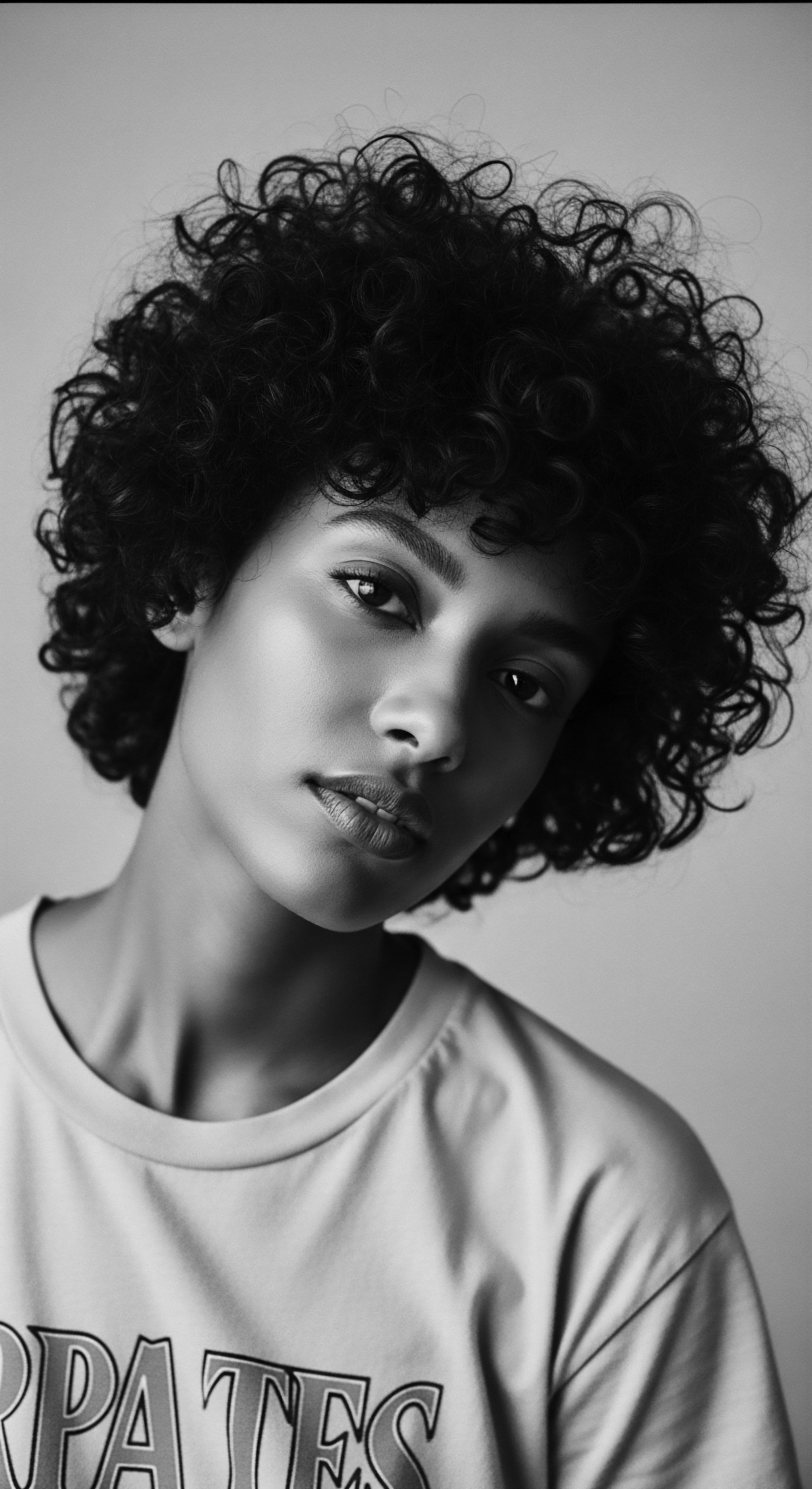
The Himba Legacy ❉ A Case Study in Ancestral Sebum Management
A powerful historical example that profoundly illuminates the Sebum Distribution’s connection to textured hair heritage is the enduring practice of the Himba Women of Namibia. For centuries, the Himba, a semi-nomadic pastoralist community, have adorned their skin and hair with Otjize, a distinctive paste composed of butterfat, red ochre pigment, and sometimes aromatic resin. This practice, deeply embedded in their cultural identity and daily life, serves as a remarkable testament to ancestral ingenuity in managing hair’s moisture and protection in an arid environment.
The butterfat component of otjize functions as an external emollient, providing a lipid layer that compensates for the inherent difficulty of natural sebum in fully traversing the highly coiled Himba hair strands. In a climate characterized by intense sun and dry air, this application is not merely aesthetic; it is a critical protective measure, effectively mimicking and augmenting the natural barrier function of sebum. The lipids lubricate the hair shaft, reducing friction, sealing in moisture, and safeguarding the hair from environmental stressors. This sophisticated, centuries-old practice demonstrates a profound, practical understanding of hair biology and the necessity of external lipid supplementation for textured hair, long predating modern scientific frameworks.
It represents a living tradition where hair care is inextricably linked to cultural identity, environmental adaptation, and ancestral knowledge of botanical and animal resources. (Rifkin, 2015)
The resilience of these practices, even through periods of immense socio-political upheaval and cultural suppression, speaks volumes. During the transatlantic slave trade, enslaved Africans were systematically stripped of their traditional hair care tools and practices, often having their heads shaved as a brutal act of dehumanization. Yet, amidst unimaginable hardship, they adapted, utilizing available resources like bacon grease, butter, or kerosene to attempt to lubricate and manage their hair, demonstrating a desperate yet persistent effort to address the fundamental need for moisture and protection that their natural sebum distribution could not fully provide. This historical continuity, from the intentional crafting of otjize to the desperate improvisation of enslaved communities, underscores the enduring biological reality of textured hair’s needs and the profound human drive to care for and adorn it.
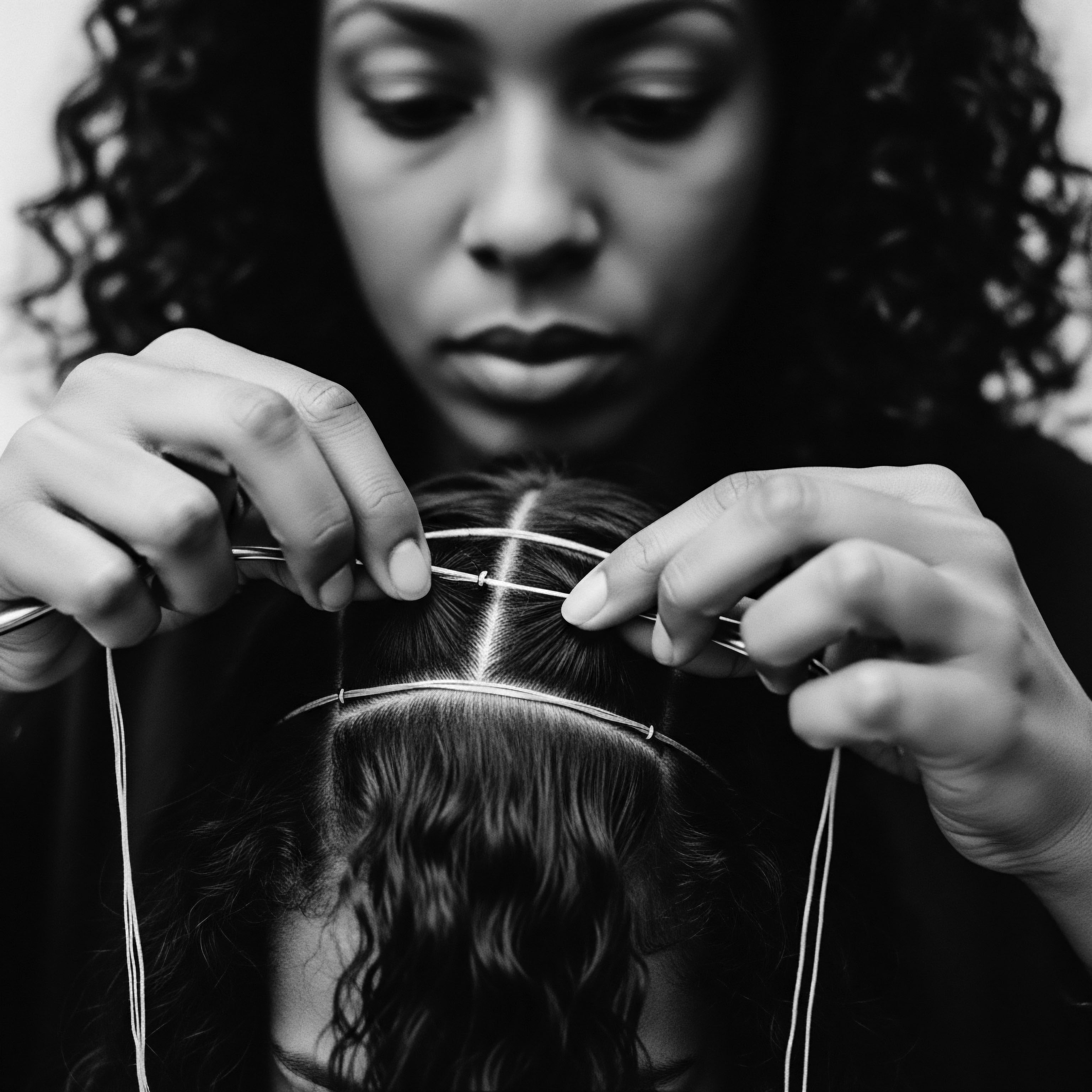
Interconnected Incidences and Long-Term Consequences
The academic lens also allows for an examination of the interconnected incidences that arise from the unique Sebum Distribution patterns in textured hair and the historical responses to them. The consistent dryness of the hair shaft, particularly the ends, leads to increased fragility and susceptibility to mechanical damage. This heightened vulnerability often necessitates specific styling practices, such as protective styles (braids, twists, locs), which historically served to minimize manipulation and retain moisture. However, the societal devaluation of these traditional styles, rooted in Eurocentric beauty standards that privileged straight hair, led to widespread hair discrimination.
This discrimination, a pervasive issue even today, has profound long-term consequences, impacting not only self-perception and mental well-being but also economic opportunities and social mobility for individuals with textured hair. The pressure to conform to straightened aesthetics often led to the use of chemical relaxers and excessive heat, further compromising the hair’s integrity and exacerbating the very dryness issues that stem from sebum distribution challenges. This creates a cyclical dilemma ❉ the natural characteristics of textured hair necessitate specific care, yet societal norms often punish adherence to those very practices, forcing individuals into choices that can harm their hair and spirit.
The re-emergence of the natural hair movement, particularly since the early 2000s, represents a powerful reclamation of heritage and a profound re-evaluation of Sebum Distribution’s true meaning. It is a collective recognition that the inherent properties of textured hair are not deficiencies to be corrected, but rather unique characteristics to be understood, celebrated, and cared for with informed intention. This movement has spurred scientific inquiry into the specific needs of textured hair, often validating the efficacy of ancestral practices through modern dermatological and cosmetic science. For example, research now confirms that certain natural oils, long used in traditional African hair care, possess fatty acid profiles that can effectively penetrate the hair shaft and provide substantive conditioning, thus compensating for uneven sebum coverage.
- Follicular Morphology ❉ The elliptical or flattened cross-section of textured hair follicles results in a helical growth pattern, significantly hindering the uniform downward spread of sebum.
- Lipid Composition ❉ While sebum is crucial for all hair types, textured hair may benefit more significantly from external lipid supplementation due to its compromised natural distribution.
- Mechanical Vulnerability ❉ The dryness caused by uneven sebum distribution contributes to increased friction and breakage susceptibility, necessitating gentle handling and protective styling.
The academic understanding of Sebum Distribution, therefore, is not merely a biological fact; it is a lens through which we can appreciate the historical resilience, cultural wisdom, and ongoing journey of self-acceptance within textured hair communities. It calls for a holistic approach that respects both the scientific realities of hair biology and the profound heritage of care that has sustained generations.
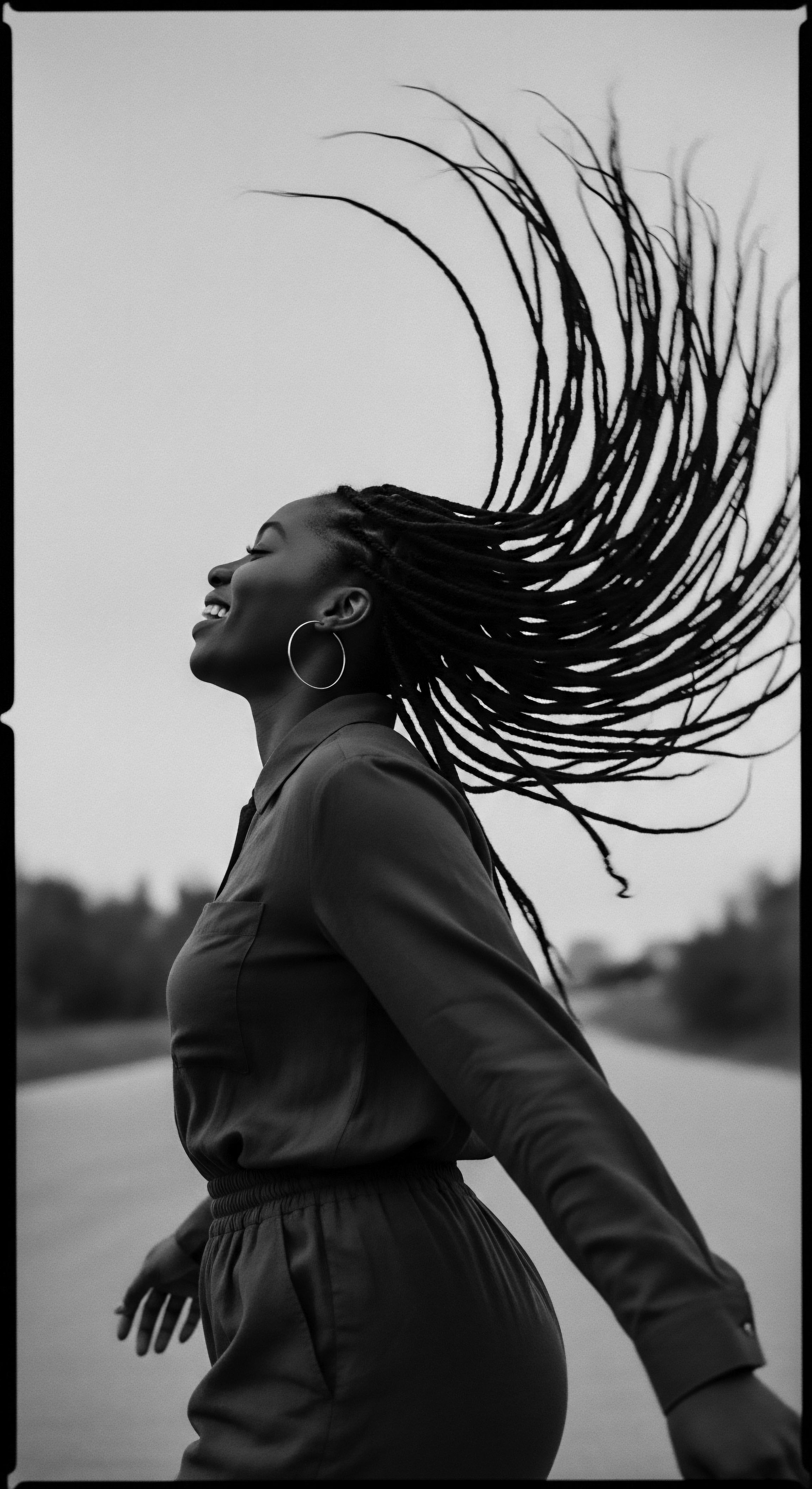
Reflection on the Heritage of Sebum Distribution
As we conclude our exploration of Sebum Distribution, the narrative shifts from scientific delineation to a deeper meditation on its enduring resonance within the Soul of a Strand. This seemingly simple biological process—the journey of natural oils along the hair—unfurls into a rich tapestry of heritage, resilience, and profound self-acceptance. The unique challenge presented by textured hair’s glorious coils and kinks, which naturally impede the even spread of sebum, has not been a flaw to be overcome, but rather a catalyst for ancestral ingenuity and a cornerstone of cultural identity.
From the ancient hearths where hands lovingly massaged natural butters into scalps, to the quiet resilience of enslaved ancestors who found ways to nurture their hair with improvised remedies, the understanding of sebum distribution has always been present, woven into the very fabric of communal care. It is a testament to the profound wisdom of those who recognized the hair’s thirst and responded with the earth’s bounty. This ancestral knowledge, passed down through the generations, often without written word, speaks to a deep connection to the body, to nature, and to the collective spirit.
Today, as the natural hair movement continues its powerful ascent, the concept of Sebum Distribution takes on renewed significance. It is no longer just a biological fact but a symbol of reclamation. By understanding how our hair naturally behaves, how its unique structure interacts with its own protective oils, we are empowered to make informed choices that honor our heritage.
This understanding allows us to move beyond imposed beauty standards and to truly celebrate the inherent beauty and strength of textured hair. It invites us to listen to the whispers of our strands, to respect their ancestral needs, and to cultivate practices that foster holistic well-being.
The journey of sebum, from its humble origin in the sebaceous gland to its intended path along the hair shaft, mirrors the journey of textured hair itself ❉ a path often challenged, yet always finding a way to flourish, to protect, and to express a boundless spirit. In recognizing and addressing the nuances of sebum distribution, we not only care for our hair but also affirm a vital part of our collective heritage, ensuring that the tender thread of ancestral wisdom continues to guide future generations in their reverence for the unbound helix of their hair. This ongoing dialogue between science and tradition allows us to see our hair not as a burden, but as a living legacy, deeply rooted and eternally beautiful.
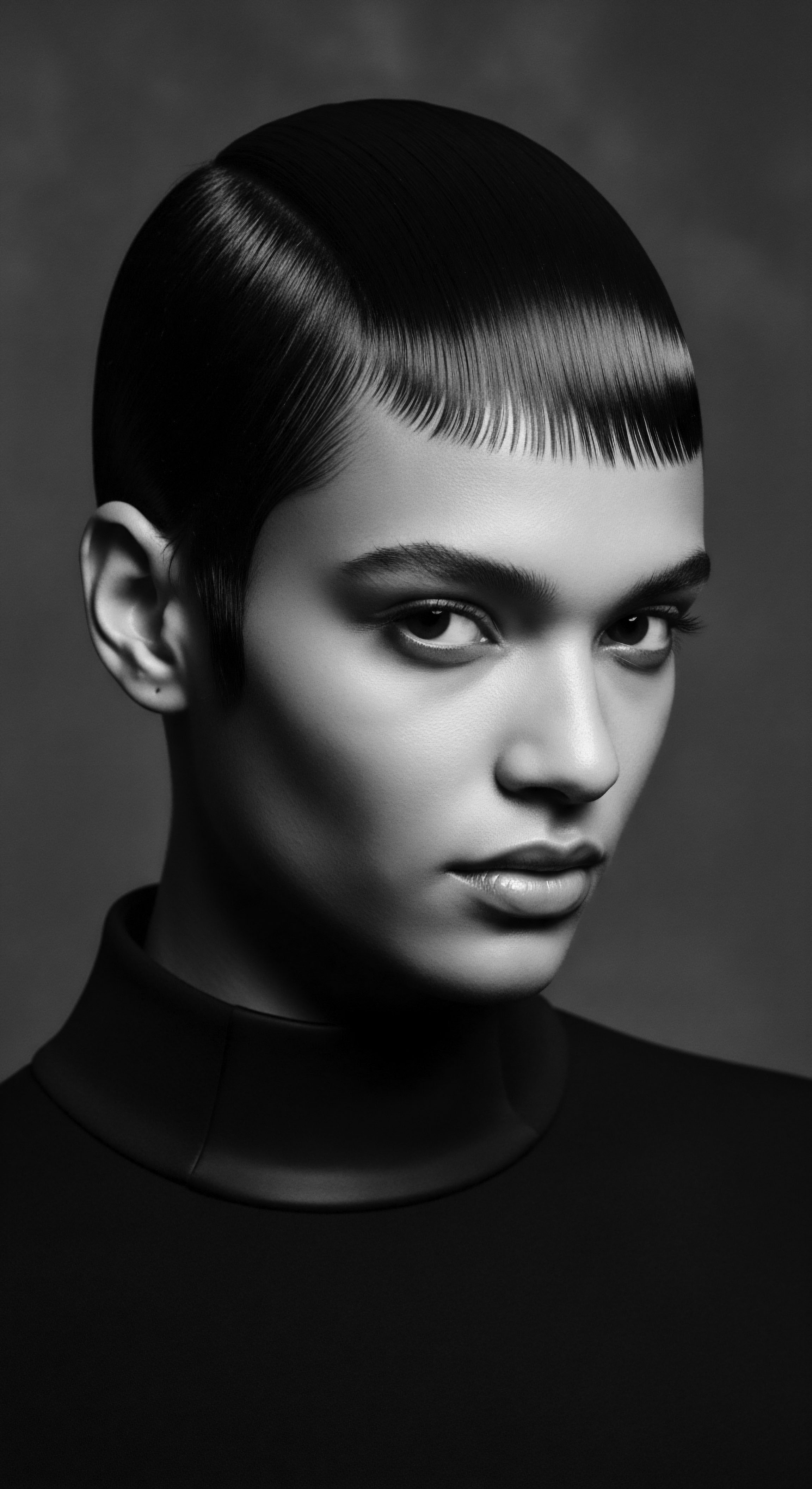
References
- Byrd, A. & Tharps, L. L. (2001). Hair Story ❉ Untangling the Roots of Black Hair in America. St. Martin’s Press.
- Crandall, D. P. (2004). The Himba of Namibia. Indiana University Press.
- d’Errico, F. & Rifkin, R. F. (2014). Otjise Chest. ResearchGate. DOI ❉ 10.13140/2.1.2366.8002.
- Havenga, D. Akoba, R. Menzi, L. Azizi, S. Sackey, J. Swanepoel, N. Gibaud, A. & Maaza, M. (2022). Himba red ochre ❉ An exceptional UV filter and solar heat IR reflector. Journal of the European Academy of Dermatology and Venereology, 36(12), 2277-2287.
- Khumalo, N. P. & Gumedze, F. (2010). The chemical and physical properties of African hair. In African Hair ❉ Its structure, health and care. CRC Press.
- Oforiwa, A. (2023). The History and Culture of African Natural Hair ❉ From Ancient Times to Modern Trends. AMAKA Studio .
- Revan, D. (2024). Hair, History, and Healthcare ❉ The Significance of Black Hairstyles for Dermatologists. VisualDx .
- Rifkin, R. F. (2015). The Himba and Red Ochre—Aesthetics, Symbolism, and Adaptation. ResearchGate .
- Sherrow, V. (2006). Encyclopedia of Hair ❉ A Cultural History. Greenwood Press.
- Toscani, M. & Fino, P. (n.d.). Sebaceous glands. CRLab. Retrieved from https://www.crlab.com/en/glossary/sebaceous-glands/
- Walker, A. (2001). Madam C.J. Walker ❉ The Life and Legacy of the First Black Female Millionaire. Jossey-Bass.
